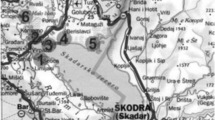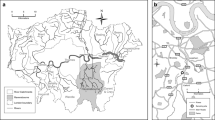Abstract
The contribution of erosion of bed sediment to the load of metals leaving Lake Ketelmeer, a shallow lake in the Netherlands fed by the IJssel branch of the River Rhine, is reported. Transport of suspended matter and associated trace metals was measured using both centrifuges and sediment traps at several locations in the lake. Mass balances of suspended matter and heavy metals were calculated using data from these field measurements.
Metal/scandium-ratios were used to identify the source of the suspended matter in the lake. Since the bed sediment is more polluted than the suspended sediment entering the lake, higher metal/scandium-ratios were found for bottom sediment in the lake compared with those for suspended matter entering the lake from the River IJssel. Using the metal/scadium-ratio in suspended matter from the lake, it was calculated that bottom sediments made up 43% of the suspended matter leaving the lake. This implies an erosion flux of bottom sediment of 16 g m−2 d−1. For cadmium, mercury, chromium and zinc, this erosion process accounts for more than 50% of the pollutant load leaving Lake Ketelmeer and entering Lake IJsselmeer.
Similar content being viewed by others
References
Ackermann, F., 1980. A procedure for correcting the grain size effect in heavy metal analyses of estuarine and coastal sediments. Envir. Technol. Letters 1: 518–527.
Ackerman, F., H. Bergmann & U. Schleichert, 1983. Monitoring of heavy metals in coastal and estuarine sediments — a question of grain-size: < 20 µm versus < 60 µm. Envir. Technol Letters 4: 317–328.
Allan, R. J. & G. J. Brunskill, 1977. Relative atomic variation (RAV) of elements in lake sediments: lake Winnipeg and other Canadian lakes. In H. L. Golterman (ed) Interactions between sediments and fresh water. Proc. Int. Symp. Amsterdam the Netherlands. Dr W. Junk Publishers, The Hague: 108–120.
Asper, V. L., 1987. A review of sediment trap technique. MTS Journal 21: 18–25.
Comans, R. N. J., J. J. Middelburg, J. Zonderhuis, J. R. W. Woittiez, G. J. De Lange, H. A. Das & C. H. Van Der Weijden, 1989. Mobilization of radiocaesium in pore water of lake sediments. Nature 339: 367–369.
Förstner, U. & G. T. W. Wittmann, 1979. Metal pollution in the aquatic environment. Springer-Verlag, Berlin, 486 pp.
Hargrave, B. T. & N. M. Burns, 1979. Assessment of sediment trap collection efficiency. Linmol. Oceanogr. 24: 1124–1136.
Malle, K.-G., 1985. Metallgehalt and Schwebstoffgehalt im Rhein II. Z. Was ser-Abwasser-Forsch. 18: 207–209.
Salomons, W., 1983. Trace metals in the Rhine, their past and present (1920–1983) influence on aquatic and terrestrial ecosystems. In G. Muller (ed.), International Conference Heavy Metals in the Environment, Heidelberg. CEP Consultants: 764–771.
Salomons, W. & U. Förstner, 1984. Metals in the Hydrocycle. Springer-Verlag, Berlin, 349 pp.
Salomons, W., E. Schwedhelm, J. Schoer & H. Knauth, 1988. Natural tracers to determine the origin of sediments and suspended matter from the Elbe estuary. Wat. Sci. Technol. 20: 89–102.
Sokal, R. R. & F. J. Rohlf, 1969. Biometry. W. H. Freeman and Company, San Fransisco, 776 pp.
Van der Weijden, C. H. & J. J. Middelburg, 1989. Hydrogeochemistry of the river Rhine: long term and seasonal variability, elemental budgets, base levels and pollution. Wat Res. 23: 1247–1266.
Westrich, B., 1986. Hydromechanic aspects of contaminated sediment transport in fluvial systems. In P. G. Sly (ed.), Sediments and Water Interactions. Springer Verlag New York: 63–68.
Winkels, H. J., A. van Diem & J. Driebergen, 1991. Extent and degree of pollution of the sediment in the lake Ketelmeer. In Proceedings 6th Congress of the International Association of Engineering Geology, Amsterdam, The Netherlands (in press).
Author information
Authors and Affiliations
Rights and permissions
About this article
Cite this article
ten Hulscher, T.E.M., Mol, G.A.J. & Lüers, F. Release of metals from polluted sediments in a shallow lake: quantifying resuspension. Hydrobiologia 235, 97–105 (1992). https://doi.org/10.1007/BF00026203
Issue Date:
DOI: https://doi.org/10.1007/BF00026203




